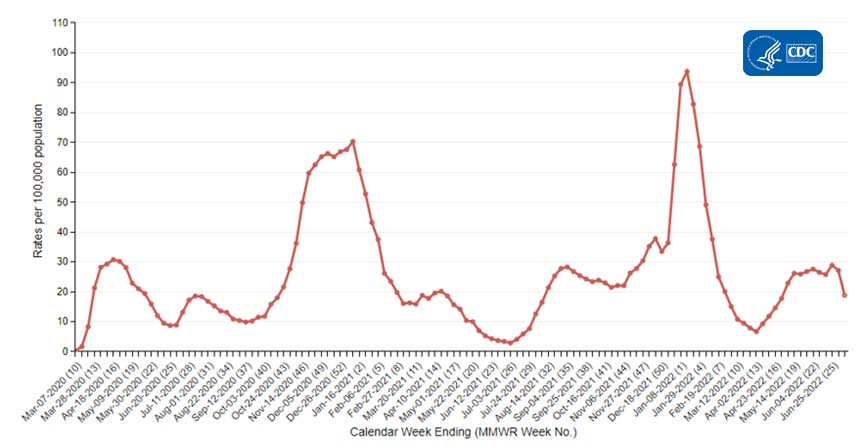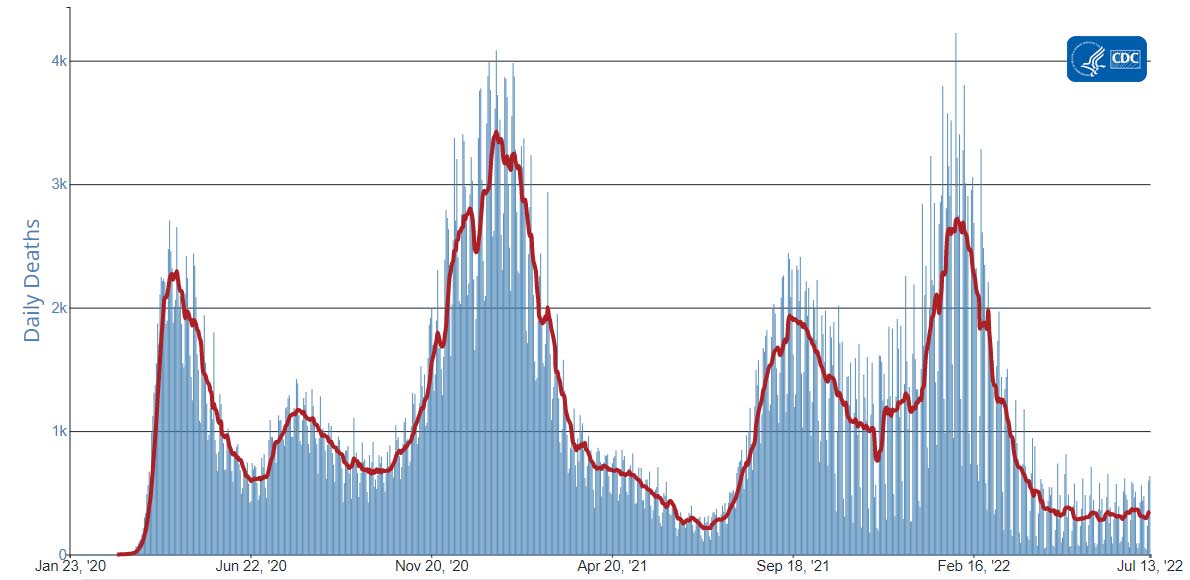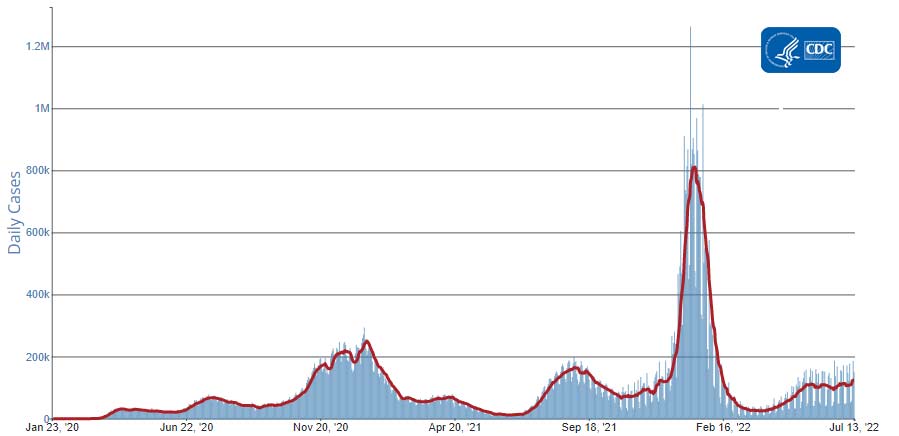Recommendations for Fully Vaccinated People
COVID-19 Homepage
Act Now. Get Boosted.
Interpretive Summary for July 15, 2022
Act Now. Get Boosted.
In March 2022, CDC recommended a second COVID-19 booster for adults ages 50 years and older and people ages 12 years and older who have weakened immune systems. So far, only about 28% of adults ages 50 years and older with a first booster dose have received a second booster dose. This means that millions of people are now six or seven months past their first booster and could be more vulnerable to BA.4 and BA.5, the newest lineages of Omicron.
Data suggest that BA.4 and BA.5 spread more easily than previous Omicron lineages. They’ve been on the rise for weeks, and BA.5 has become the predominant lineage in the United States (see A Closer Look). So more people—even those who might have protection from past infection or vaccination—have gotten COVID-19, and COVID-19-associated hospitalization rates and death rates have risen among older adults.
The good news is that a new CDC study found that second boosters can restore vaccine protection against hospitalization that might have dropped over time. New surveillance data have also shown that second boosters provide additional protection against death from COVID-19 in people ages 50 years and older (see A Closer Look).
Act now to protect yourself and others around you.
- Get boosted if eligible, even if you’ve already had COVID-19, and especially if you’re over age 50 years or have underlying medical conditions.
- Monitor your local COVID-19 Community Level and take appropriate prevention measures.
- Follow CDC’s testing and isolation guidelines if you are exposed to COVID-19 or have symptoms.
Note to Readers: Not sure if you should get tested? CDC’s Viral Testing Tool can help you decide if you should get tested and what your test results mean. To find out if you are eligible for a second COVID-19 booster, use CDC’s Booster Tool.
- COVID Data Tracker’s Vaccine Effectiveness tab was updated to include a new vaccine effectiveness study published in June 2022.
- COVID Data Tracker’s Rates of COVID-19 Cases and Deaths by Vaccination Status tab was updated to include new data on second boosters.
- COVID Data Tracker’s County View tab now displays data on first booster doses for people ages 5 years and older, by county.
- Safety Monitoring of COVID-19 mRNA Vaccine First Booster Doses Among Persons Aged ≥12 Years with Presumed Immunocompromise Status — United States, January 12, 2022–March 28, 2022
- Effectiveness of 2, 3, and 4 COVID-19 mRNA Vaccine Doses Among Immunocompetent Adults During Periods when SARS-CoV-2 Omicron BA.1 and BA.2/BA.2.12.1 Sublineages Predominated — VISION Network, 10 States, December 2021–June 2022
COVID-19 Community Levels
As of July 14, 2022, there are 1,141 (35.4%) counties, districts, or territories with a high COVID-19 Community Level, 1,275 (39.6%) counties with a medium Community Level, and 804 (25.0%) counties with a low Community Level. Compared with last week, this represents an increase (+14.8 percentage points) in the number of high-level counties, an increase (+1.8 percentage points) in the number of medium-level counties, and a corresponding decrease (−16.4 percentage points) in the number of low-level counties. 50 out of 52 jurisdictions* had high- or medium-level counties this week. Rhode Island and Maine are the only jurisdictions to have all counties at low Community Levels.
To check your COVID-19 Community Level, visit COVID Data Tracker. To learn which prevention measures are recommended based on your COVID-19 Community Level, visit COVID-19 Community Level and COVID-19 Prevention.
*Includes the 50 states, the District of Columbia, and Puerto Rico.
Reported Cases
As of July 13, 2022, the current 7-day moving average of daily new cases (124,048) increased 15.7% compared with the previous 7-day moving average (107,174). A total of 88,932,987 COVID-19 cases have been reported in the United States as of July 13, 2022.
Variant Proportions
CDC Nowcast projections* for the week ending July 9, 2022, estimate that the combined national proportion of lineages designated as Omicron will continue to be 100% with the predominant Omicron lineage being BA.5, projected at 65.0% (95% PI 62.2-67.7%).
There are several lineages of Omicron and within each are multiple sublineages. The national proportion of BA.2.12.1 is projected to be 17.3% (95% PI 15.7-19.0%), BA.4 is projected to be 16.3% (95% PI 14.5-18.3%), and BA.2 is projected to be 1.4% (95% PI 1.3-1.6%). See COVID Data Tracker for current data.
88,932,987
Total Cases Reported
88,932,987
Total Cases Reported
124,048
Current 7-Day Average**
124,048
Current 7-Day Average**
107,174
Prior 7-Day Average
107,174
Prior 7-Day Average
15.7%
Change in 7-Day Average since Prior Week
15.7%
Change in 7-Day Average since Prior Week
*The median time from specimen collection to sequence data reporting is about 3 weeks. As a result, weighted estimates for the most recent few weeks may be unstable or unavailable. CDC’s Nowcast is a data projection tool that helps fill this gap by generating timely estimates of variant proportions for variants that are circulating in the United States. View Nowcast estimates on CDC’s COVID Data Tracker website on the Variant Proportions page.
**Historical cases are excluded from daily new cases and 7-day average calculations until they are incorporated into the dataset for the applicable date. Of 536,361 historical cases reported retroactively, 2,698 were reported in the current week and none were reported in the prior week.
Vaccinations
The U.S. COVID-19 Vaccination Program began December 14, 2020. As of July 13, 2022, 599.3 million vaccine doses have been administered in the United States. Overall, about 260.7 million people, or 78.5% of the total U.S. population, have received at least one dose of vaccine. About 222.7 million people, or 67.1% of the total U.S. population, have been fully vaccinated.* Of those fully vaccinated, about 107.0 million people have received a booster dose,** but 50.2% of the total booster-eligible population has not yet received a booster dose.
CDC’s COVID Data Tracker displays vaccination trends by age group, race/ethnicity, and urban/rural status. To see trends by age group and race/ethnicity, visit the Vaccination Demographic Trends tab. To see trends by urban/rural status, visit the COVID-19 Vaccination Equity tab.
599,289,113
Vaccine Doses Administered
599,289,113
Vaccine Doses Administered
260,728,030
People who received at least one dose
260,728,030
People who received at least one dose
222,682,315
People who are fully vaccinated*
222,682,315
People who are fully vaccinated*
78.5%
Percentage of the U.S. population that has received at least one dose
78.5%
Percentage of the U.S. population that has received at least one dose
67.1%
Percentage of the U.S. population that has been fully vaccinated*
67.1%
Percentage of the U.S. population that has been fully vaccinated*
+0.1
Percentage point increase from last week
+0.1
Percentage point increase from last week
+0.1
Percentage point change from last week
+0.1
Percentage point change from last week
*Represents the number of people who have received the second dose in a two-dose COVID-19 vaccine series (such as the Pfizer-BioNTech or Moderna vaccines) or one dose of the single-shot Johnson & Johnson’s Janssen vaccine.
**Represents the number of people who are fully vaccinated and have received another dose of COVID-19 vaccine since August 13, 2021. This includes people who received their first additional dose or booster dose.
Hospitalizations
New Hospital Admissions
The current 7-day daily average for July 6–12, 2022, was 5,851. This is a 14.4% increase from the prior 7-day average (5,115) from June 29–July 5, 2022.
4,947,473
Total New Admissions
4,947,473
Total New Admissions
5,851
Current 7-Day Average
5,851
Current 7-Day Average
5,115
Prior 7-Day Average
5,115
Prior 7-Day Average
+14.4%
Change in 7-Day Average
+14.4%
Change in 7-Day Average
The start of consistent reporting of hospital admissions data was August 1, 2020.
Daily Trends in Number of New COVID-19 Hospital Admissions in the United States

New admissions are pulled from a 10 am EDT snapshot of the HHS Unified Hospital Data – Analytic Dataset. Due to potential reporting delays, data from the most recent 7 days, as noted in the figure above with the grey bar, should be interpreted with caution. Small shifts in historic data may also occur due to changes in the Centers for Medicare & Medicaid Services (CMS) Provider of Services file, which is used to identify the cohort of included hospitals.
COVID-NET: Hospitalization Rates among Adults Ages ≥65 Years
CDC’s Coronavirus Disease 2019-Associated Hospitalization Surveillance Network (COVID-NET) shows that overall rates of COVID-19-associated hospitalizations have increased since the week ending April 2, 2022. Notably, rates among adults ages 65 years and older have seen a sharp increase, from 6.7 per 100,000 population on April 2, to 26.2 per 100,000 population on May 14. These rates have remained elevated and relatively unchanged in recent weeks, ranging from 25.8 to 28.9 per 100,000 between May 14 and June 25.
Hospitalization Rates among Adults Ages ≥65 Years

The Coronavirus Disease 2019 (COVID-19)-Associated Hospitalization Surveillance Network (COVID-NET) is an additional source for hospitalization data collected through a network of more than 250 acute-care hospitals in 14 states (representing ~10% of the U.S. population). Detailed data on patient demographics, including race/ethnicity, underlying medical conditions, medical interventions, and clinical outcomes, are collected using a standardized case reporting form.
Deaths
The current 7-day moving average of new deaths (352) has increased 12.6% compared with the previous 7-day moving average (312). As of July 13, 2022, a total of 1,018,035 COVID-19 deaths have been reported in the United States.
1,018,035
Total Deaths Reported
1,018,035
Total Deaths Reported
352
Current 7-Day Average*
352
Current 7-Day Average*
312
Prior 7-Day Average
312
Prior 7-Day Average
12.6%
Change in 7-Day Average Since Prior Week
12.6%
Change in 7-Day Average Since Prior Week
**Historical deaths are excluded from the daily new deaths and 7-day average calculations until they are incorporated into the dataset by their applicable date. Of 21,756 historical deaths reported retroactively, none were reported in the current week; and none were reported in the prior week.
Daily Trends in Number of COVID-19 Deaths in the United States Reported to CDC

7-Day moving average
 More Death Data
More Death DataTesting
The percentage of COVID-19 NAATs (nucleic acid amplification tests)* that are positive (percent positivity) is increasing in comparison to the previous week. The 7-day average of percent positivity from NAATs is now 17.5%. The 7-day average number of tests reported for July 1–7, 2022, was 520,155, down 2.4% from 533,202 for the prior 7 days.
921,423,930
Total Tests Reported
921,423,930
Total Tests Reported
520,155
7-Day Average Tests Reported
520,155
7-Day Average Tests Reported
17.5%
7-Day Average % Positivity
17.5%
7-Day Average % Positivity
17.3%
Previous 7-Day Average % Positivity
17.3%
Previous 7-Day Average % Positivity
+0.19
Percentage point change in 7-Day Average % Positivity since Prior Week
+0.19
Percentage point change in 7-Day Average % Positivity since Prior Week
*Test for SARS-CoV-2, the virus that causes COVID-19
Wastewater Surveillance
COVID Data Tracker’s Wastewater Surveillance tab tracks levels, changes, and detections of SARS-CoV-2* viral RNA in wastewater at over 1,000 testing sites across the country.
Currently, most of the country is reporting moderate to high SARS-CoV-2 levels in wastewater. Around 42% of sites are currently seeing some of the highest levels for those sites since December 1, 2021. About 36% of all sites reporting wastewater data are experiencing a decrease in SARS-CoV-2 levels, and about 54% are reporting an increase. It’s important to note that even a small increase when levels are low can appear like a dramatic increase in the percent change.
For more information on how to use wastewater data visit CDC’s website
*The virus that causes COVID-19
SARS-CoV-2 Levels in Wastewater by Site

0% means levels are the lowest they have been at the site; 100% means levels are the highest they have been at the site.
A Closer Look
Learn More about BA.4 and BA.5 and Recent Booster Data
Viruses like SARS-CoV-2, which is the virus that causes COVID-19, continuously evolve as they spread. As SARS-CoV-2 genomes change, scientists classify groups of similar genomes into lineages and sublineages. Particularly important lineages and their descendant lineages are often called “variants” and named after Greek letters, like Omicron. CDC uses genomic surveillance to track and learn more about the SARS-CoV-2 lineages circulating in the United States.
In recent weeks, CDC has monitored increases in the BA.4 and BA.5 lineages of Omicron. As of the week ending July 9, 2022, BA.4 and BA.5 represent an estimated 16.3% and 65.0% respectively, of the SARS-CoV-2 variants currently circulating in the United States. Data suggest that these lineages could be more transmissible than previous Omicron sublineages. However, there is no evidence currently available to suggest that BA.4 and BA.5 cause more severe disease than other variants or Omicron lineages. CDC is continuing to assess the impact that BA.4 and BA.5 have on public health.
CDC uses case data, rates of COVID-19 hospitalizations, and healthcare capacity in communities to estimate the burden of COVID-19 on local healthcare systems. COVID-19 Community Levels currently indicate that the impact of COVID-19 is increasing in many areas of the United States.
A combination of factors—including changes in the virus and waning protection as individuals get further away from their last immunity-inducing event (vaccination or infection)—can lead to less protection against infection, severe disease, or even death from COVID-19. However, a new CDC study found that first and second COVID-19 vaccine boosters significantly increased protection against COVID-19-associated hospitalization in people of eligible ages. Additionally, CDC surveillance data show that adults ages 50 years and older with two boosters had 4 times lower risk of dying from COVID-19, compared to people who received one booster. People with two boosters also had 29 times lower risk of dying from COVID-19 than people who are unvaccinated. The key takeaway from these findings is simple: Staying up to date on vaccines by getting boosted as soon as you’re eligible is critical to maintaining individual protection against COVID-19.
As the virus changes, we can expect some new lineages to cause more cases and COVID-19 community levels to change. In these periods, such as we are seeing right now, it is important to monitor your local COVID-19 Community Levels, stay up to date with vaccines, and take appropriate precautions to protect yourself and others.







